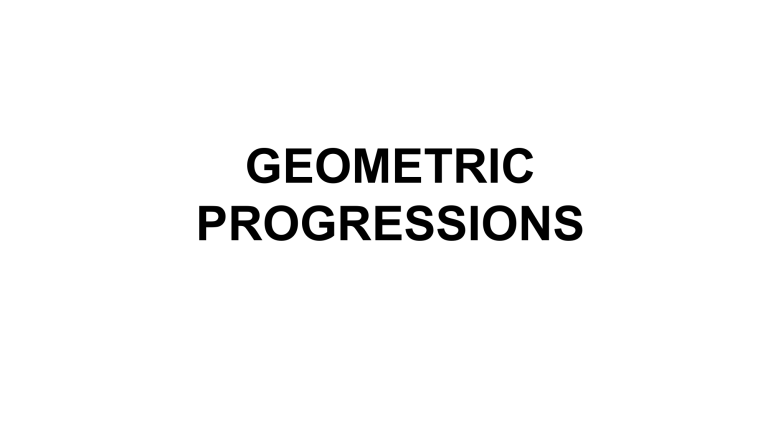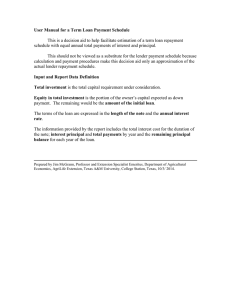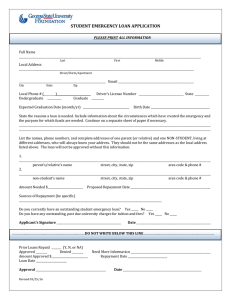
GEOMETRIC PROGRESSIONS A Geometric Progression (GP) or Geometric Series is one in which each term is found by multiplying the previous term by a fixed number (common ratio). e.g. 5 + 10 + 20 + 40 + … or 2 – 4 + 8 –16 + … If the first term is denoted by a, and the common ratio by r, the series can be written as: a + ar + ar2 + ar3 + … Hence the nth term is given by: un ar n 1 The sum of the first n terms, Sn is found as follows: Sn = a + ar + ar2 + ar3 +…ar n–2 + ar n–1 …(1) Multiply throughout by r: r Sn = ar + ar2 + ar3 + ar4 + …ar n–1 + ar n …(2) Now subtract (2) – (1): Factorise: r Sn – Sn = ar n – a Sn (r – 1) = a (r n – 1 ) a(r 1) Sn r 1 n Hence: Example 1: For the series 2 + 6 + 18 + 54 + … Find a) The 10th term. b) The sum of the first 8 terms. a) For the series, we have: a = 2, r = 3 Using: un = ar n–1 u10 = 2(3 9) a(r n 1) b) Using Sn r 1 = 39 366 2(38 1) S8 = 6560 3 1 Example 2: For the series 32, –16, + 8, – 4, +2, … Find a) The 12th term. b) The sum of the first 7 terms. a) For the series, we have: Using: un = ar n–1 1 – a = 32, r = 2 11 1 1 – – ( ) = u12 = 32 2 64 a(1 r n ) a(r n 1) We can write this as: Sn b) Since Sn 1 r r 1 (This ensures that the denominator is positive). 32(1 ( 12 )7 ) S7 = 21.5 1 1 ( 2 ) Summary of key points: A Geometric Series is one in which the terms are found by multiplying each term by a fixed number (common ratio). The nth term is given by: un ar n 1 The sum of the first n terms is given by: a(r n 1) Sn r 1 In problems where r < 1 it is better to write the above as: a(1 r n ) Sn 1 r Sum to infinity problems a(1 r n ) Sn 1 r For some problems we find that n = infinity. In these cases when r >1 the sum S ∞ will be infinity and r < 1 the sum S ∞ will modify the above equation to 𝑎 S∞= 1−𝑟 Calculations of compound interest where the principal amount remains unchanged A student borrows £27000 to fund their degree course. If the interest on the loan is 6% and they can borrow the money over 30 years, calculate the total amount repayable. Pn = a 1 + r 𝑛 = 27000 1 + 0.06 30 = £155074 1. If £200 is invested every year at compound interest of 4% per annum, Determine a) the value at the end of 12 years, b) the time, correct to the nearest year, it takes to reach more than £600 un ar n 1 If £200 is invested at a compound interest of 4% per annum, Determine a) the value after end of 12 years, b) the time, correct to the nearest year, it takes to reach more than £600 (a) Let the GP be a, ar, ar2, . .How many terms are there in this series ? there are 12 terms in total The first term ar 0 = £200 The common ratio r =1.04 The 2nd term is ar1 = (200)(1.04) = £2.08, which is the value after 1 year. The 3rd term is ar2 = (200)(1.04)2 = £216.32, which is the value after 2 years. Thus the value after 12 complete years ar13-1 =(200) (1.04)12 = £320.21 (b) When £600 has been reached, 600=arn-1 i.e. 600 = 200(1.04)n-1 and therefore 3 = (1.04)n-1 Taking logs of both sides gives: log 3 = (n-1) log (1.04) by the laws of logarithms from which, n-1 = log 3 log 1.04 = 28 Hence it will take over 29 years to reach more than £600 2. Someone inherits £10,000 and decides to invest this for their pension fund. Assuming it will be at the start of the 45th year before they can retire how much will this be worth if the average interest rate over this period is 5%. If a sibling receives a similar amount but delays in investing this money in a similar fund for 10 years what will their final pension pot be worth. (£85,572, £52,534) un ar n 1 The value at the start of 45th year is; ar45-1 =(10000) (1.05)44 = £ 85,572 The value at the start of the 34th year of the pension fund is; ar34-1 =(10000) (1.05)33 = £ 50,032 3. A hire tool firm finds that their net return from hiring tools is decreasing by 12% per annum. If their profit on a certain tool this year is £500, find the possible total of all future profits from this tool (assuming the tool lasts for ever!). (£4167) 𝑎 S∞= 1−𝑟 3. A hire tool firm finds that their net return from hiring tools is decreasing by 12% per annum. If their net gain on a certain tool this year is £500, find the possible total of all future profits from this tool (assuming the tool lasts for ever!). The net gain forms a series: £500 + £500 × 0.88 + £500 × 0.882 +・ ・ ・ , which is a GP with a =500 and r =0.88 The sum to infinity, 𝑎 S∞ = (1−𝑟) = 500 1−0.88 = £4167 total future profits Exercises 4. You complain that the hot tub in your hotel suite is not hot enough. The hotel tells you that they will increase the temperature by 10% each hour. If the current temperature of the hot tub is 75º C, what will be the temperature of the hot tub after 3 hours, to the nearest tenth of a degree? 5. A mine worker discovers an ore sample containing 500 mg of radioactive material. It is discovered that the radioactive material has a half life of 1 day. Find the amount of radioactive material in the sample at the beginning of the 7th day. 4. You complain that the hot tub in your hotel suite is not hot enough. The hotel tells you that they will increase the temperature by 10% each hour. If the current temperature of the hot tub is 75º C, what will be the temperature of the hot tub after 3 hours, to the nearest tenth of a degree? Starting temperature is 75ºC. If the temperature is increased by 10% in the first hour and every subsequent hour, the new temperature will be 110% of the previous and therefore the common ratio will be 1.10 There are 4 terms ar0 + ar1 + ar2 + un= ar n-1 a4=75 x 1.10 (4-1) ar3. Initial temp 75oC, after 1 hour, after 2 hours, after 3 hours therefore 4 terms in total Therefore after 3 hours the temperature = 99.8℃ 5. 500 mg of ore. Half life of one day means that half of the amount remains after 1 day. Decide to either work with the "beginning" of each day, or the "end" of each day, as each can give the correct answer but only the starting value and number of terms will differ. The example below uses "beginning": Begin of day 1 Begin of day 2 Begin of day 3 500 mg 250 mg 125 mg End of day 1 250 mg End of day 2 125 mg End of day 3 62.5 mg ... ... Monthly Loan repayments 𝑟(1 + 𝑟)𝑛 𝑀=𝑃 (1 + 𝑟)𝑛 −1 M=Monthly repayment P=Principal amount (How much you borrowed) r= Monthly interest rate (eg 4 % = 0.04/12 = 0.003) n=number of months loan is for (eg 25 years x 12=300) A (wealthy !) student decides to help the environment by buying an electric car instead of one that uses petrol/diesel. The car is going to cost £70,000 borrowed over 10 years at an interest rate of 7%. What are his monthly payments going to be and what is the total cost of the car if he/she decides to go ahead with the purchase. 𝑟(1 + 𝑟)𝑛 𝑀=𝑃 (1 + 𝑟)𝑛 −1 Monthly repayment = ? Total repayment = ? P=Principal amount = £70,000 r= Monthly interest rate 7 % = 0.07/12 = 5.83333333 x10-3 n=number of months loan is for = 10 x 12 = 120 6. A couple get married and decide to buy a house for £250,000. If the interest rate is stable at 4% for the entire period of the loan what will they have paid back if they take out a mortgage for i) 25 years ii) 35 years. (£395712, £464659) What will their monthly repayments for each loan period? (£1319, £1106) 7. A student takes out a loan for £42,000 to cover living costs and tuition fees. How much will he /she have to repay over the 30 years of the loan period if the interest rate on the loan is 6%. What will be his monthly repayment? (£90652, £252)


